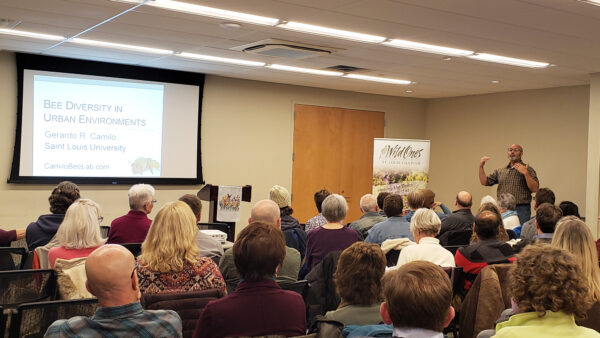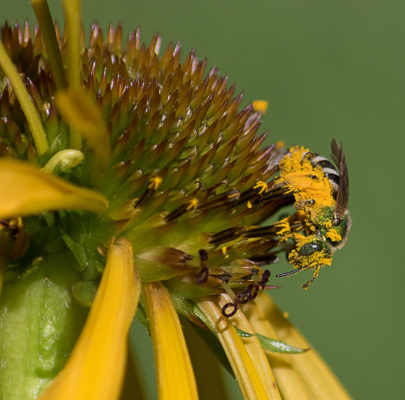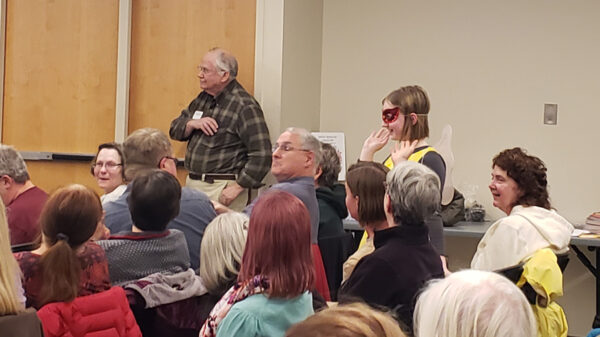Wild Ones Gathering
12 February 2020
Brentwood Community Center
Attendance: 59 members + 3 children and 15 Guests
Marsha opened the meeting talking about our all-volunteer chapter and how we all contribute time and effort, money to our mission: Healing the Earth one yard at a time! She then welcomed everyone and recognized members, and guests. She invited our guests to join us and detailed the benefits of membership.
Then she went on to introduce our guest speaker, Dr. Gerardo Camilo, Professor and Researcher at St Louis University (SLU). His talk tonight was titled “Bee Diversity in Urban Environments”
 Dr Camilo said that emerging scientific literature supports the claim that one yard at a time DOES and CAN make a difference! He then acknowledged the obstacles we face such as our neighbors using chemicals, and local ordinances preventing the ‘wild’ or natural appearance of some native planted yards.
Dr Camilo said that emerging scientific literature supports the claim that one yard at a time DOES and CAN make a difference! He then acknowledged the obstacles we face such as our neighbors using chemicals, and local ordinances preventing the ‘wild’ or natural appearance of some native planted yards.
Dr. Camilo oversees state of the art conservation projects through St. Louis University’s Billiken Bee Lab. These include studying birds, bees, mosquitos, specialist bees vs. generalists, soil, and wing morphology.
Beginning in 2013, Dr. Camilo and Damon Hall (also a researcher at SLU), partnered with Missouri Dept. of Conservation to survey native bee diversity in the St Louis area. His fieldwork has been conducted in cemeteries, community gardens, urban parks, roof top gardens, vacant lots and anywhere he can go with his net! Missouri is home to 450 native bees species, including Bumblebees, out of the nearly 4000 native species in the United States. After several years, Dr. Camilo discovered that St Louis has nearly 45% of the bee diversity in our state! Laughing, he said, ‘This is not what I expected to find’.
Dividing our metropolitan area into three areas, he went on to describe what he found in the North, Central and South corridors of our city. These novel ecosystems are described as follows: The North area has had a shrinking population loss resulting in more green spaces and fewer manicured lawns. The Central corridor has a combination of open spaces, urban gardens and manicured lawns. The South corridor has a greater predominance of manicured lawns. Neighborhoods with more areas of cultivated lawns have less bee diversity than neighborhoods with a more varied landscape. So it was no surprise that he found more native bees were in the North corridor, followed by fewer in the Central corridor and the least in the South corridor.
Dr. Camilo recommends the following strategies to support our beautiful bees:
- Plant natives and include varieties to span the growing season so you always have something in bloom. Bees like diversity!
- Mow your grass less. Every two weeks, instead of every week, increases the native bee population by 60%. Every third week produced a 300% increase!
- Mulch less, leave bare spots for the bees to make their nests. Exposed soil is great for them to burrow in. 70% of our native bees are ground nesters!
- Plant flowers in with your vegetables.
- Build or buy bee houses when possible.
- Postpone fall cleanup. Leaving the dead stems and clumps of leaves will make the bees happy.
- Be careful when using pesticides–or avoid them altogether.
 He also recommended two books by Heather Holm. They can be purchased from the Wild Store , from the visitor center at Shaw Nature Reserve, and from Heather’s website. Also on her website you’ll find downloadable Native Plants for Native Bees posters.
He also recommended two books by Heather Holm. They can be purchased from the Wild Store , from the visitor center at Shaw Nature Reserve, and from Heather’s website. Also on her website you’ll find downloadable Native Plants for Native Bees posters.
• Pollinators of Native Plants: Attract, Observe and Identify Pollinators and Beneficial Insects with Native Plants
• Bees: An identification and Native Plant Forage Guide
While I tried to capture Dr. Camilo’s many funny comments, I was too interested in listening to get them written down. So I hope you remember and laugh again!
Recorded by
Ginny Johnson, Secretary


